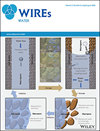所属分类:SCI期刊
Wiley Interdisciplinary Reviews-water期刊基本信息

WIRES WATER
2049-1948
4.436
SCIE
UNITED STATES
6 issues/year
2014
Wiley Interdisciplinary Reviews-water中文介绍
《Wiley Interdisciplinary Reviews-water》是一本由WILEY出版商出版的专业地学期刊,该刊创刊于2014年,刊期6 issues/year,该刊已被国际权威数据库SCIE收录。在中科院最新升级版分区表中,该刊分区信息为大类学科:地球科学 2区,小类学科:环境科学 2区;水资源 2区;在JCR(Journal Citation Reports)分区等级为Q1。该刊发文范围涵盖环境科学等领域,旨在及时、准确、全面地报道国内外环境科学工作者在该领域取得的最新研究成果、工作进展及学术动态、技术革新等,促进学术交流,鼓励学术创新。2021年影响因子为7.428,
Wiley Interdisciplinary Reviews-water英文介绍
Overview
The award-winning WIREs (Wiley Interdisciplinary Reviews) series combines some of the most powerful features of encyclopedic reference works and review journals in an innovative online format. They are designed to promote a cross-disciplinary research ethos while maintaining the highest scientific and presentational standards, but should be viewed first and foremost as evolving online databases of cutting-edge reviews.
WIREs Water
An important new forum to promote cross-disciplinary understanding of the water environment, and the severe challenges that it faces during the 21st Century
An authoritative, encyclopedic resource addressing key topics from the perspectives of earth sciences, biology, engineering, social sciences, and humanities
High-quality content commissioned from expert contributors and peer-reviewed to a rigorous standard
Content is fully citable, qualifying for abstracting, indexing, and ISI ranking
For more information, please go to wires.wiley.com/water.
Aims and Scope
The scope of WIREs Water is at the interfaces between five very different intellectual themes: the basic science of water, its physics and chemistry, flux, and things that it transfers and transforms; life in water, and the dependence of ecosystems and organisms on water to survive and to thrive; the engineering of water to furnish services and to protect society; the people who live with, experience and manage the water environment; and those interpretations that we, as a society, have brought to water through art, religion, history and which in turn shapes how we come to understand it. These interfaces are not simply designed to be ways of looking at water through what necessarily must be interdisciplinary perspectives. They are also designed to be outward facing in terms of how water can help to understand wider questions concerning our environment and human-environment interactions.
Topics:
Engineering Water
The contributions made by the engineering sciences to the ways in which we engineer and plan water: water, health and sanitation, including water supply, waste and disposal, infectious and waterborne diseases, public health, environmental standards: the sustainable engineering of water, including source protection, water conservation and recycling, resilience to natural hazards, waste and drainage systems, waterproofed urban landscapes, enhancing ecosystems through engineering; planning water including planning concepts, path dependency, retrodiction and prediction, forecasting, holistic analysis of water.
Human Water
Perspectives from the social sciences and humanities on our water condition: water governance, including decision-making processes, rules, customs, laws and accountability in water management; the value of water, including water pricing, more-than-economic valuation of water, hidden and embedded water (e.g. in energy, food), alternative definitions of the ‘clean’ and the ‘safe’; the rights to water, including distributive justice, entitlements and their definition, water conflicts across spatial scales; water as imagined and represented, in the creative arts, across world views, in memory and through communication.
Science of Water
The physics and chemistry of water: hydrological processes throughout the hydrological cycle; stocks and flows of water and the matter that it entrains, transports and deposits, at different spatial and temporal scales; water extremes in stocks and flows and there distributions in space and time; water quality, including solutes, sediment and temperature and its control by water flow pathways and transit times; water and environmental change, including climate, land use and flow regulation.
Water and Life
The ecology and biology of freshwater environments: the nature of freshwater ecosystems, including their structure and organisation, inter-connectivity, emergent properties, sensitivity and resilience; stresses and pressures on ecosystems, at the scales of species, habitats and ecosystems, and including multiple stressors; conservation, management and awareness including restoration, the analysis of ecosystem services, questions of spatial and temporal scale and public engagement with freshwater ecosystems.
Wiley Interdisciplinary Reviews-water中科院分区
| 大类学科 | 分区 | 小类学科 | 分区 | Top期刊 | 综述期刊 |
| 地球科学 | 2区 | ENVIRONMENTAL SCIENCES 环境科学 WATER RESOURCES 水资源 | 2区 2区 | 否 | 是 |
Wiley Interdisciplinary Reviews-water期刊近9年JCR分区变化趋势
Wiley Interdisciplinary Reviews-waterJCR分区(JCR2021-2022年分区)
| JCR分区等级 | JCR所属学科 | 分区 | 影响因子 |
| Q1 | ENVIRONMENTAL SCIENCES | Q1 | 7.428 |
| WATER RESOURCES | Q1 |
Wiley Interdisciplinary Reviews-water期刊近7年影响因子变化趋势
Wiley Interdisciplinary Reviews-water期刊的CiteScore值(CiteScore2021-2022年CiteScore值)
| CiteScore | SJR | SNIP | 学科类别 | 分区 | 排名 | 百分位 |
| 6.90 | 1.839 | 2.113 | 大类:Engineering 小类:Ocean Engineering | Q1 | 5 / 98 |
95% |
| 大类:Engineering 小类:Aquatic Science | Q1 | 14 / 234 |
94% |
|||
| 大类:Engineering 小类:Oceanography | Q1 | 12 / 139 |
91% |
|||
| 大类:Engineering 小类:Ecology | Q1 | 44 / 437 |
90% |
|||
| 大类:Engineering 小类:Water Science and Technology | Q1 | 26 / 237 |
89% |
|||
| 大类:Engineering 小类:Management, Monitoring, Policy and Law | Q1 | 48 / 376 |
87% |
Wiley Interdisciplinary Reviews-water期刊近7年自引率变化趋势